We got the old lady dressed. All of her parts were labeled. Many sheets had been cut and rolled into beautiful balls. We loaded the shuttles.
The kids were beside themselves. We used a bit of grant money to pay for a sub for Wildabest so she could be with us all day. My sister, the fiber arts professor, stopped in for a few hours to lend support and much needed technical support. Wildabest and I were still figuring Aunt Sally out.
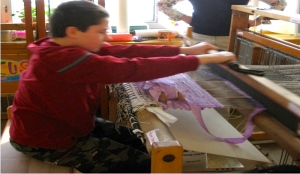
We documented the day with little snippets of what we were observing, reminders to ourselves about how to handle little kinks we ran into. We noted who needed accommodations and problem solved. It was a glorious day, a day full of hope and joy and questions, and awe. The kids were amazing. Many declined recess. We stepped aside right away and had the first weaver teach the next weaver. He was our first ‘expert’. We took notes about how gentle the kids were with Aunt Sally and each other. We had other adults wander in and out, a few of the students from my program invited their classroom pals in to have a look.
At the end of that first day Wildabest and I knew this was the best thing either of us had ever done as teachers.
This is the most important part of the story. What follows is the heart and soul of the whole rhythmic loom project. This is why it worked. It’s powerful.
 What we know about kids receiving EBD services-
What we know about kids receiving EBD services-
- They are negatively viewed and thought of as destructive and non-contributing members of the school.
- They suffer from academic underachievement.
- They have little self-worth and feel inconsequential.
- They act out in ways that repel others.
Given just those truths, we knew we needed to empower the students by giving them a way to contribute positively, a way to be seen as positive members of the school community, to be experts in something. We wanted the whole school to come into ‘that’ room and benefit from Aunt Sally. We had to give this group of kids every opportunity to redefine themselves.
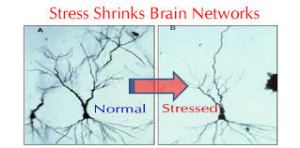 Brain based research pointed us in the direction of rhythmic repetitive movement. Not only to decrease maladaptive behavior, but to encourage new neural pathways and to strengthen brain wiring in hopes of improving learning and attending. We believed that if kids have a strong sense of well-being, they do better emotionally, socially and academically.
Brain based research pointed us in the direction of rhythmic repetitive movement. Not only to decrease maladaptive behavior, but to encourage new neural pathways and to strengthen brain wiring in hopes of improving learning and attending. We believed that if kids have a strong sense of well-being, they do better emotionally, socially and academically.
We believed, from researching, observing and reading the testimonials I received about weaving, that time with Aunt Sally would make a difference.
- Rhythmic and kinesthetic activities strengthen and fine-tune a child’s ability to more effectively learn reading and math concepts.
- Rhythmic exercises have proven to integrate primitive reflexes that are important for reading and writing.

- Rhythmic movement increases the ability to maintain focus.
- Rhythmic movement reduces stress.
- Rhythmic movement helps to filter out unwanted sensory information
- Repetitive rhythmic activity conducted prior to and during oral reading impacts reading performance.
- Rhythmic exercises have proven to integrate primitive reflexes that are important for reading and writing.
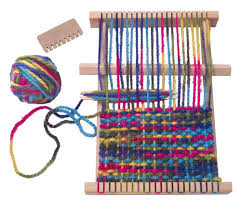 On an emotional level, creating beautiful things and moving your body rhythmically increases your sense of well-being.
On an emotional level, creating beautiful things and moving your body rhythmically increases your sense of well-being.
- The acts of moving, creating and giving improve brain chemistry.
- Weaving on a loom provides auditory rhythm as well as body in motion rhythm.
- The act of making and creating improves brain chemistry and encourages new growth of neural pathways.
- The act of teaching strengthens brain efficiency.
- Random acts of kindness, observed or performed change brain chemistry.
To ensure that the use of Aunt Sally served only those purposes we had firm rules about how she would be used. If we had not followed this one rule, Aunt Sally would have had little effect.
AUNT SALLY WAS NOT USED AS A REWARD OR PUNISHMENT
Time with Aunt Sally was not something to be earned.
- Contingent motivators (if/then) actually de-motivate unless the rules are simple and there is a narrow focus and a single solution. (Alphie Kohn)
- The purpose of Aunt Sally was to allow the student to regain self-control and to instill a better sense of well-being so learning could take place.
- We want engagement first.
- Students need some autonomy each day. Especially students with sensory and emotional challenges.
- If the brain spends most of its time in hyper-vigilance and attending to basic needs (including safety) that brain is not in a position to take on academics. Weaving provides an opportunity to be in a calm state.
I know some of you are thinking that kids will use Aunt Sally to get out of 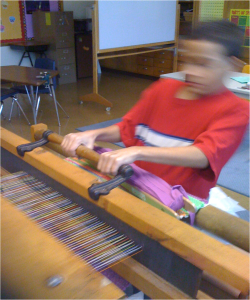 work. My answer is this. So what? If we have students avoiding work, then it’s on us to figure out why and fix it. Maybe weaving is the only thing that student can do today. If so, then it’s a darn good thing we have Aunt Sally, isn’t it? Sitting at a loom and weaving is better than tearing your room apart, disrupting the class, picking fights. The teachers I worked with were so supportive. Instead of sending kids to ‘the EBD room’, they started suggesting, before maladaptive behaviors presented, ‘would you like to go be with Aunt Sally?’ Isn’t that amazing? My wonderful teacher pals were replacing negative and punitive language with suggestions to visit with Aunt Sally.
work. My answer is this. So what? If we have students avoiding work, then it’s on us to figure out why and fix it. Maybe weaving is the only thing that student can do today. If so, then it’s a darn good thing we have Aunt Sally, isn’t it? Sitting at a loom and weaving is better than tearing your room apart, disrupting the class, picking fights. The teachers I worked with were so supportive. Instead of sending kids to ‘the EBD room’, they started suggesting, before maladaptive behaviors presented, ‘would you like to go be with Aunt Sally?’ Isn’t that amazing? My wonderful teacher pals were replacing negative and punitive language with suggestions to visit with Aunt Sally. 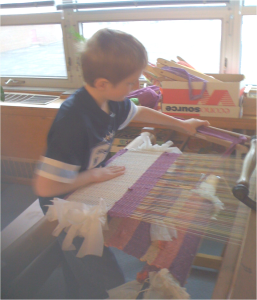 I love them for that. The students would also request to go see Aunt Sally for a bit when they were feeling out of sorts, and those teachers, who I l
I love them for that. The students would also request to go see Aunt Sally for a bit when they were feeling out of sorts, and those teachers, who I l ove
ove  so much, always granted permission.
so much, always granted permission. 
Do you see how profound that was? We had shifted from punitive to preventative, to self-monitoring, to self-awareness. WOW!
Here is more magic. The students would come to Aunt Sally, weave for however long they needed, sometimes 10 minutes, sometimes 20, sometimes they worked in their daily schedule like right before math. And get this- when THEY determined they were in a good place, they would head back to class. All on their own. Teachers reported positive differences in behavior, attending and learning after these visits to Aunt Sally. The kids were better able to deal with frustration because of time with Aunt Sally.
And the most magical thing of all was how the kids shared Aunt Sally. Without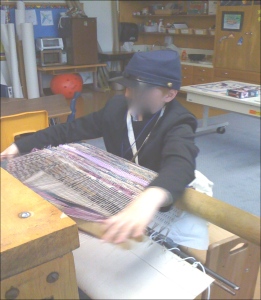 my direction. One such incident will stay with me forever. A 5th grader was at the loom. He had come in on his own to get in a better place for a class that gave him trouble. He had been at Aunt Sally for about 5 minutes. We heard a door slam down the hallway and looked at each other waiting for the door slammer to enter our room. We just figured it was one of us. It was. A 6th grader entered, threw his math text book across the room. The fifth grader sitting at Aunt Sally, moved over and said, “Hey, you can have Aunt Sally now.” He said it with such compassion, such heart, such ernest. Makes me tear up remembering it.
my direction. One such incident will stay with me forever. A 5th grader was at the loom. He had come in on his own to get in a better place for a class that gave him trouble. He had been at Aunt Sally for about 5 minutes. We heard a door slam down the hallway and looked at each other waiting for the door slammer to enter our room. We just figured it was one of us. It was. A 6th grader entered, threw his math text book across the room. The fifth grader sitting at Aunt Sally, moved over and said, “Hey, you can have Aunt Sally now.” He said it with such compassion, such heart, such ernest. Makes me tear up remembering it.
What you should know about that 5th grader is he was one of the angriest kids I had ever worked with. I had, until that day, never seen this side of him. That is the power of Aunt Sally.
Tomorrow I will finish up the story with tidbits of the logistics and how that first year of Aunt Sally ended.
Don’t you want to know how many rugs the kids made in just 3 months? Don’t you want to know what we did with the rugs? Don’t you want to know what happened next?
You know you do. See you then.

Fantastic. Research based activity, results based — oh, heck, results! If you’d had my son in class, (blind, Asperger’s), I know the two of you would have figured out what kinds of accommodation he needed and then made it happen. I love seeing your students as capable and competent.
LikeLike
I would have loved having your son in my group! We would have made it work.
LikeLike
Your compassionate 5th grader hit me right in the feels!! Love Aunt Sally and love your dedication and understanding of so many misunderstood kiddos!
LikeLike
Thank you, Becky. Misunderstood kiddos are my specialty.☺️
LikeLike